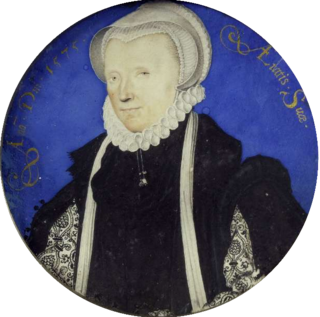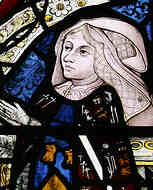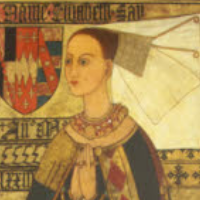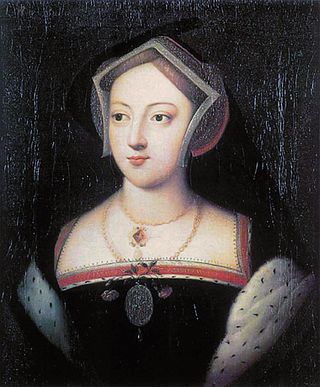Related Research Articles

Anne Boleyn was Queen of England from 1533 to 1536, as the second wife of King Henry VIII. The circumstances of her marriage and execution, by beheading for treason, made her a key figure in the political and religious upheaval that marked the start of the English Reformation.

Anne of the Thousand Days is a 1969 British historical drama film based on the life of Anne Boleyn, directed by Charles Jarrott and produced by Hal B. Wallis. The screenplay by Bridget Boland and John Hale is an adaptation of the 1948 play of the same name by Maxwell Anderson.
The Private Life of Henry VIII is a 1933 British film directed and co-produced by Alexander Korda and starring Charles Laughton, Robert Donat, Merle Oberon and Elsa Lanchester. It was written by Lajos Bíró and Arthur Wimperis for London Film Productions, Korda's production company. The film, which focuses on the marriages of King Henry VIII of England, was a major international success, establishing Korda as a leading filmmaker and Laughton as a box-office star.

Margaret Douglas, Countess of Lennox, was the daughter of the Scottish queen dowager Margaret Tudor and her second husband Archibald Douglas, 6th Earl of Angus, and thus the granddaughter of King Henry VII of England and the half-sister of King James V. She was the grandmother of King James VI and I.
Elizabeth Boleyn, Countess of Wiltshire was an English noblewoman, noted for being the mother of Anne Boleyn and as such the maternal grandmother of Elizabeth I of England. The eldest daughter of Thomas Howard, 2nd Duke of Norfolk and his first wife Elizabeth Tilney, she married Thomas Boleyn sometime in the later 15th century. Elizabeth became Viscountess Rochford in 1525 when her husband was elevated to the peerage, subsequently becoming Countess of Ormond in 1527 and Countess of Wiltshire in 1529.

In common parlance, the wives of Henry VIII were the six queens consort of King Henry VIII of England between 1509 and his death in 1547. In legal terms, Henry had only three wives, because three of his marriages were annulled by the Church of England. He was never granted an annulment by the Pope, as he desired, however, for Catherine of Aragon, his first wife. Annulments declare that a true marriage never took place, unlike a divorce, in which a married couple end their union. Along with his six wives, Henry took several mistresses.

The Boleyn Inheritance is a novel by British author Philippa Gregory which was first published in 2006. It is a direct sequel to her previous novel The Other Boleyn Girl, and one of the additions to her six-part series on the Tudor royals. The novel is told through the first-person narratives of – Anne of Cleves, Katherine Howard, and Jane Boleyn, who was mentioned in The Other Boleyn Girl. It covers a period from 1539 until 1542 and chronicles the fourth and fifth marriages of King Henry VIII of England.

Mary FitzRoy, Duchess of Richmond and Somerset, born Mary Howard, was a daughter-in-law of King Henry VIII of England, being the wife of his illegitimate son Henry FitzRoy, 1st Duke of Richmond and Somerset.
Alison Weir is a British author and public historian. She primarily writes about the history of English royal women and families, in the form of biographies that explore their historical setting. She has also written numerous works of historical fiction.

Anne Boleyn, the second wife of King Henry VIII of England, and Queen of England from 1533 until she was beheaded in 1536 for treason, has inspired or been mentioned in many artistic and cultural works. The following lists cover various media, enduring works of high art, and recent representations in popular culture, film and fiction. The entries represent portrayals that a reader has a reasonable chance of encountering, rather than a complete catalogue.
Anne Berkeley, Baroness Berkeley was a lady-in-waiting and companion of Queen Anne Boleyn, the second wife of Henry VIII of England. She was reputed to be one of the witnesses at the secret wedding ceremony of the King and Anne Boleyn which occurred on 25 January 1533.

Mary Boleyn, also known as Lady Mary, was the sister of English queen consort Anne Boleyn, whose family enjoyed considerable influence during the reign of King Henry VIII.

Elizabeth Tilney, Countess of Surrey was an English heiress who became the first wife of Thomas Howard, 2nd Duke of Norfolk. She served successively as a lady-in-waiting to two Queen consorts, namely Elizabeth Woodville, wife of King Edward IV, and later as Lady of the Bedchamber to that Queen's daughter, Elizabeth of York, the wife of King Henry VII. She stood as joint godmother to Princess Margaret Tudor at her baptism.

Catherine Howard was Queen of England from July 1540 until November 1541 as the fifth wife of King Henry VIII. She was the daughter of Lord Edmund Howard and Joyce Culpeper, a cousin to Anne Boleyn, and the niece of Thomas Howard, 3rd Duke of Norfolk. Thomas Howard was a prominent politician at Henry's court. He secured her a place in the household of Henry's fourth wife, Anne of Cleves, where Howard caught the King's interest. She married him on 28 July 1540 at Oatlands Palace in Surrey, just 19 days after the annulment of his marriage to Anne. He was 49, and it is widely accepted that she was about 17 at the time of her marriage to Henry VIII.
Julia Fox is an author and historical researcher, and a former teacher. She lives in London with her husband, the Tudor historian John Guy. Her first book was Jane Boleyn: The Infamous Lady Rochford, a study of the lady-in-waiting at the court of Henry VIII of England and the sister-in-law of Anne Boleyn. Her second book, Sister Queens, is a biography of sisters Katherine of Aragon, who was Henry VIII's first wife, and Joanna of Castile, who was the mother of Charles V, Holy Roman Emperor.
Elizabeth, Lady Boleyn was a lady-in-waiting at the court of Henry VIII of England. Through her marriage to Sir James Boleyn, she was the aunt of Henry VIII's second wife, Anne Boleyn. The two were not close, and Elizabeth Boleyn acted as her niece's gaoler when Queen Anne was arrested on charges of adultery, incest and conspiracy to kill the King.
Elizabeth Chamber, better known as Elizabeth Stonor, was an English courtier. She is remembered as the wife of Sir Walter Stonor, and was one of the women chosen to serve Anne Boleyn, the king's second wife, during her imprisonment in 1536.
Joan Champernowne, Lady Denny was a lady-in-waiting at the court of King Henry VIII of England. She became the friend and lady-in-waiting to his sixth wife, Queen Catherine Parr.

Elizabeth Cheney was a member of the English gentry, who was the great-grandmother of Anne Boleyn, Jane Seymour, and Catherine Howard, three of the wives of King Henry VIII of England, thus making her great-great-grandmother to King Edward VI, the son of Henry VIII and Jane Seymour, and Elizabeth I, the daughter of Henry VIII and Anne Boleyn. Her first husband was Sir Frederick Tilney, and her second husband was Sir John Say, Speaker of the House of Commons. She bore a total of eight children from both marriages.

The mistresses of Henry VIII included many notable women between 1509 and 1536. They have been the subject of biographies, novels and films.
References
- ↑ "Katherine Howard by Joanna Denny". Waterstones. Retrieved 21 January 2016.
- ↑ "Joanna Denny". unjobs.org. Archived from the original on 18 July 2012. Retrieved 2 February 2022.
- ↑ "Anne Boleyn by Joanna Denny". Waterstones. Retrieved 18 September 2016.